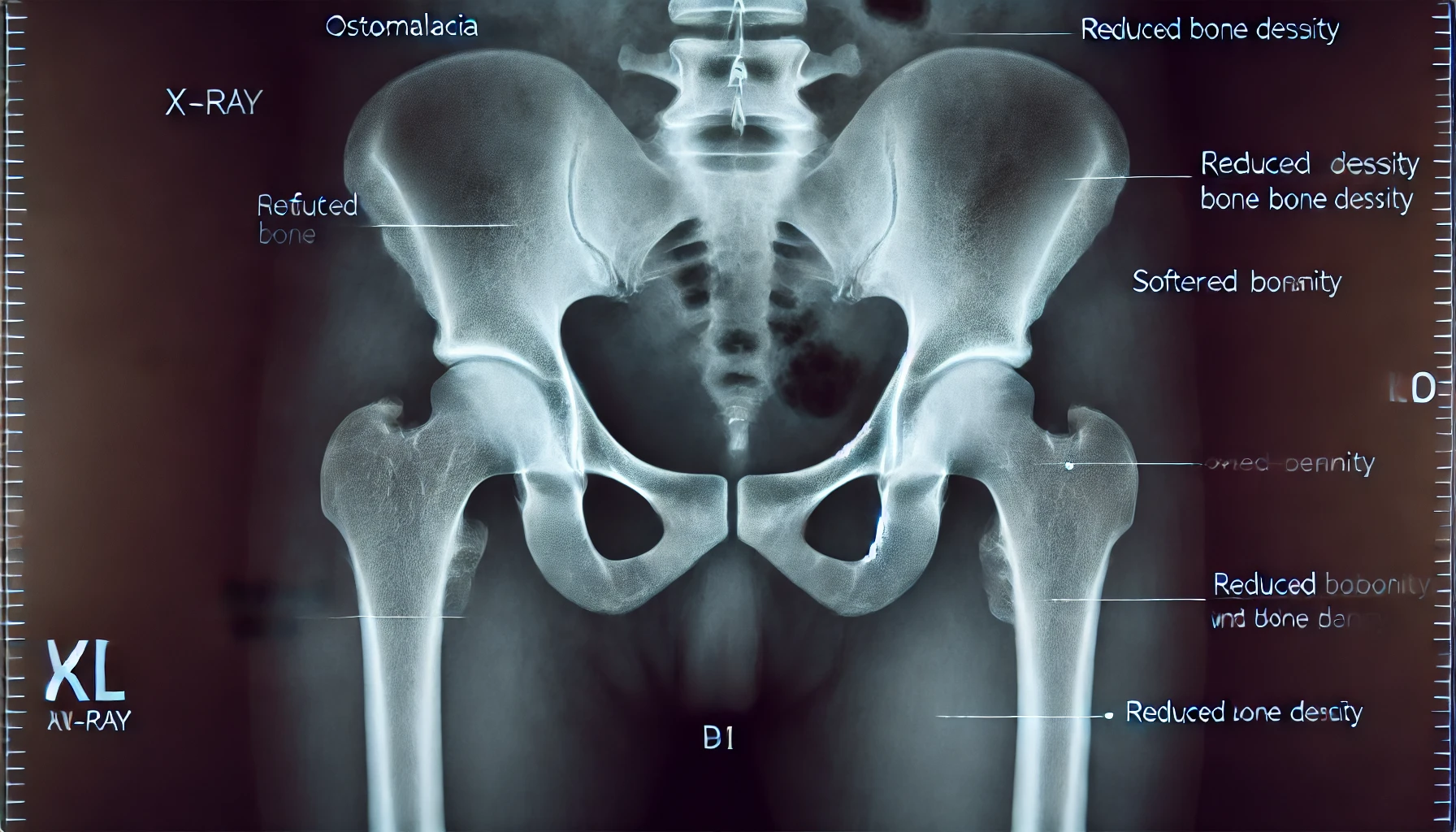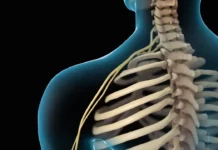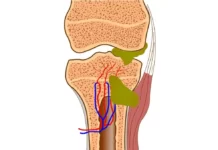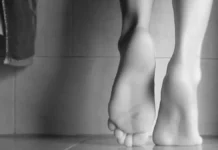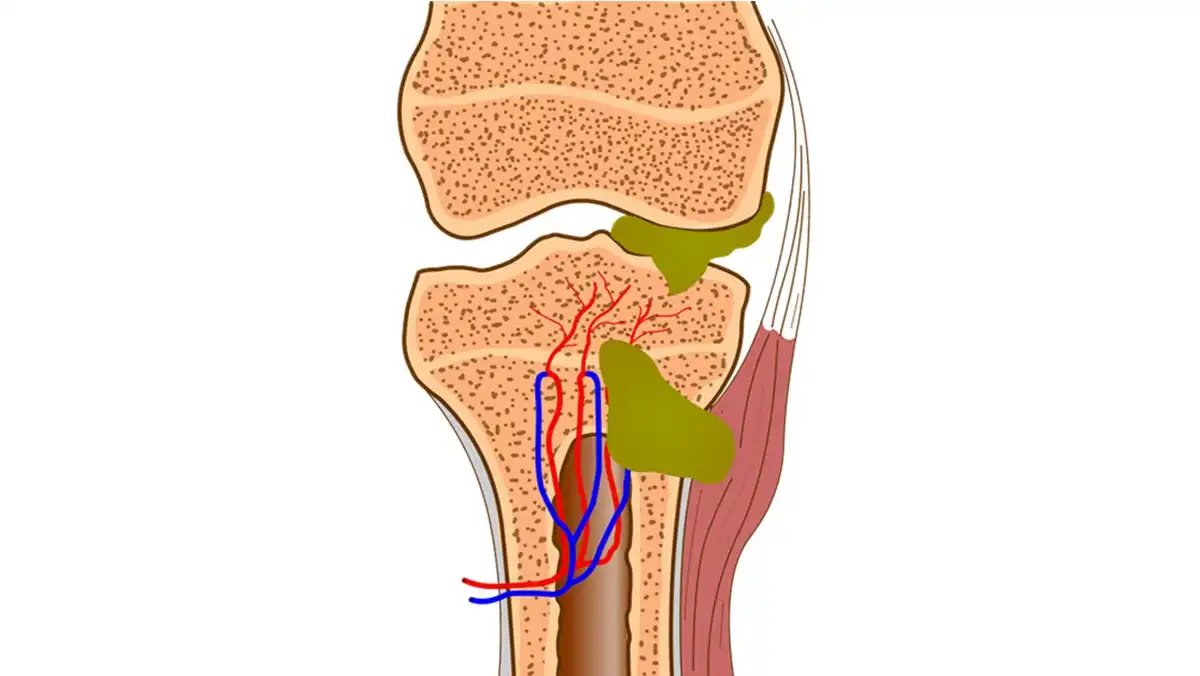Introduction to Osteomalacia
Osteomalacia, often misunderstood and overlooked, is a medical condition characterized by the softening of bones due to inadequate bone mineralization. Primarily caused by a deficiency of vitamin D, phosphorus, or calcium, this condition impacts the skeletal system’s strength and integrity, leading to increased susceptibility to fractures and deformities.
The term “osteomalacia” comes from Greek origins: ‘osteon’ meaning bone and ‘malakia’ meaning softness. Unlike osteoporosis, which involves bone density reduction, osteomalacia involves the softening of the bone material itself, making it less rigid and more likely to bend and break under normal pressure.
Understanding osteomalacia is crucial, not only for those at risk but also for the general population, to recognize the importance of maintaining adequate nutrient levels to support bone health. The condition is more prevalent in regions with low sunlight exposure, among individuals with certain dietary restrictions, or in those who suffer from specific medical conditions that affect nutrient absorption.
Early recognition and intervention can prevent many of the severe outcomes associated with osteomalacia. Thus, this section aims to shed light on the basic understanding of the disease, emphasizing the need for awareness and proactive health management. By the end of this introduction, readers should have a clear comprehension of what osteomalacia is, why it occurs, and the fundamental differences that set it apart from other bone-related ailments.
Causes of Osteomalacia
Osteomalacia results from the impaired bone mineralization process. Normally, bones undergo a continuous cycle of breakdown and renewal, which requires sufficient levels of minerals like calcium and phosphate, and the presence of vitamin D, to ensure proper formation. When these elements are deficient or their metabolism is disrupted, it can lead to the softening of the bones characteristic of osteomalacia.
Vitamin D Deficiency: The most common cause of osteomalacia is a lack of vitamin D, which is vital for calcium absorption in the gut. Without adequate vitamin D, the body cannot absorb enough calcium from the diet, leading to a decrease in the calcium available for bone formation. Vitamin D deficiency can result from inadequate dietary intake, insufficient sunlight exposure, and health conditions that impair its absorption or conversion to its active form in the liver and kidneys.
Disorders of Phosphate Handling: Phosphate is another essential mineral for bone mineralization. Conditions such as renal tubular acidosis or tumors that produce substances interfering with phosphate metabolism (e.g., fibroblast growth factor 23) can lead to phosphate wastage and, subsequently, osteomalacia.
Gastrointestinal Disorders: Diseases that affect the intestines and result in malabsorption of nutrients can also cause osteomalacia. Conditions like celiac disease, Crohn’s disease, and surgical removal of parts of the intestine significantly decrease the body’s ability to absorb fat-soluble vitamin D and other minerals necessary for bone health.
Certain Medications and Toxins: Long-term use of medications that interfere with vitamin D metabolism, such as anticonvulsants and certain antifungal drugs, can lead to osteomalacia. Exposure to toxic substances like fluoride or aluminum, especially in industrial workplaces, can also contribute to the development of this condition.
Understanding these causes is fundamental to preventing and treating osteomalacia. Individuals at risk must be monitored for nutrient levels regularly and might benefit from dietary adjustments, supplements, or changes in medication. Awareness and early intervention based on understanding these causes can significantly alter the progression of osteomalacia, emphasizing the need for both individual and healthcare professional education on this matter.
Symptoms and Early Signs
Recognizing the symptoms and early signs of osteomalacia is crucial for timely intervention and management. This condition, characterized by the softening of bones, often manifests subtly and can escalate if left untreated.
Muscle Weakness and Bone Pain: The most common early symptoms of osteomalacia are diffuse bone pain and muscle weakness, particularly in the pelvic region and lower extremities. This pain is often described as dull and aching, different from the sharp pain typically associated with injuries or fractures. The muscle weakness associated with osteomalacia can make it difficult for individuals to rise from a seated position or climb stairs.
Difficulty Walking: As the condition progresses, patients may develop a waddling gait, which is a compensatory adaptation to the weakening of the pelvic muscles and pain. This alteration in gait can further limit mobility and contribute to a decrease in physical activity levels.
Fractures: Bones affected by osteomalacia are more susceptible to fractures, especially stress fractures, which can occur even with minimal trauma. These are often seen in ribs, hips, and legs.
Psychological Impact: Chronic pain and reduced mobility can lead to significant psychological distress, including depression and anxiety. The impact on daily activities, such as difficulties in performing job duties or personal care tasks, further exacerbates these psychological challenges.
Understanding these symptoms and their impact on life is vital. Early recognition helps in initiating appropriate diagnostic and management strategies, improving the overall quality of life for those affected.
Diagnosis of Osteomalacia
Diagnosing osteomalacia involves several steps, as its symptoms often overlap with other skeletal disorders like osteoporosis. The diagnostic process typically includes a combination of clinical evaluation, biochemical tests, and imaging studies.
Clinical Evaluation: A thorough medical history and physical examination are essential. Doctors look for signs of muscle weakness, bone tenderness, and changes in gait.
Biochemical Tests: Blood tests are crucial for measuring levels of calcium, phosphate, alkaline phosphatase, and parathyroid hormone. Low calcium and phosphate levels alongside elevated alkaline phosphatase are indicative of osteomalacia.
Imaging Studies: X-rays may show bone thinning and fractures. More advanced imaging techniques like bone densitometry (DEXA scans) can assess bone density, while MRI and CT scans provide detailed images of bone structure and can help in identifying stress fractures.
Bone Biopsy: Although not routinely performed, a bone biopsy is considered the gold standard for diagnosing osteomalacia. This involves the microscopic examination of bone tissue, which can definitively show poor mineralization.
The challenge in diagnosing osteomalacia lies in its subtle early symptoms and similarities to other metabolic bone diseases. Awareness and understanding of these challenges are essential for healthcare providers to avoid misdiagnosis and ensure appropriate treatment.
Radiographic Signs of Osteomalacia
Radiography plays a crucial role in diagnosing osteomalacia, with several characteristic signs that suggest the presence of this bone-softening disease. Understanding these signs is essential for radiologists and healthcare providers to accurately diagnose and manage osteomalacia.
Pseudofractures or Looser’s Zones: One of the most characteristic findings in osteomalacia on radiographs are pseudofractures, also known as Looser’s zones. These appear as thin, radiolucent lines perpendicular to the cortical surface, often seen in areas subjected to repetitive stress. Common sites for these pseudofractures include the ribs, scapulae, pubic rami, and femoral necks. They represent areas of unmineralized osteoid and are highly suggestive of osteomalacia when observed.
Diffuse Bone Demineralization: Generalized decrease in bone density is a common radiographic feature of osteomalacia. This reduced density makes the bones appear more translucent on X-rays than normal bones. It can be challenging to differentiate from osteoporosis solely by radiography, as both conditions show decreased bone density.
Bone Deformities: In advanced cases of osteomalacia, bones may show deformities due to their softened state. These deformities can include bowing of the long bones in the legs or compression fractures in the spine. Such changes are typically more pronounced and have a different pattern compared to other metabolic bone diseases.
Protrusio Acetabuli: This condition, where the acetabulum (hip socket) protrudes into the pelvic cavity, can be an indirect sign of osteomalacia in adults. It results from the softening of the pelvic bones, allowing the femoral head to push into the acetabulum.
Skull Changes: In some cases, a ‘salt-and-pepper’ appearance of the skull can be seen in osteomalacia. This appearance is due to irregular bone resorption and deposition on the skull’s inner table, giving it a mottled look on radiographs.
Radiographic Challenges: It’s important to note that while these signs are suggestive of osteomalacia, they are not definitive alone. Early osteomalacia may show no radiographic signs at all, or the signs may be subtle, requiring correlation with clinical findings and other diagnostic tests, such as blood levels of calcium, phosphate, vitamin D, and parathyroid hormone.
Radiographic imaging provides valuable information in the assessment of osteomalacia, helping to confirm the diagnosis and assess the severity of the disease. Regular imaging can also monitor the effectiveness of treatment as changes in the radiographic appearance can reflect improvements in bone mineralization.
Differential Diagnosis
Differential Diagnosis Considerations:
- Osteoporosis:
- Similarity: Both conditions show generalized osteopenia.
- Difference: Osteoporosis does not typically feature pseudofractures. The bone loss in osteoporosis is due to a reduction in bone mass rather than a defect in the bone mineralization process. Fractures in osteoporosis are usually vertebral compression fractures and do not have the Looser’s zones typical of osteomalacia.
- Paget’s Disease of Bone:
- Similarity: Both can show bone deformities and changes in bone structure.
- Difference: Paget’s disease is characterized by a chaotic remodeling process, leading to a mixture of sclerotic and lytic lesions that are not seen in osteomalacia. Paget’s disease typically presents with enlarged bone structures, which is not a feature of osteomalacia.
- Renal Osteodystrophy:
- Similarity: May also present with bone demineralization and pseudofractures.
- Difference: Renal osteodystrophy is associated with chronic kidney disease and shows additional signs such as “rugger jersey spine” (band-like densities at the vertebral endplates) and vascular and soft tissue calcifications, which are not features of primary osteomalacia.
- Rickets (Pediatric Osteomalacia):
- Similarity: Rickets is essentially osteomalacia in children, with inadequate bone mineralization leading to similar radiographic signs.
- Difference: Rickets more prominently displays growth plate abnormalities due to active bone growth, such as cupping and fraying at metaphyses of long bones, which are absent in adult osteomalacia.
- Hypophosphatasia:
- Similarity: Presents with bone softening and may mimic osteomalacia radiographically.
- Difference: Hypophosphatasia is characterized by low levels of alkaline phosphatase and often presents with premature loss of deciduous teeth, a feature not associated with osteomalacia.
Treatment Strategies
Effective treatment of osteomalacia aims to correct the underlying causes of poor bone mineralization, primarily focusing on replenishing deficient nutrients and addressing any identifiable causes.
Supplementation: The cornerstone of treatment is the supplementation of vitamin D and calcium. Depending on the severity, this may involve high-dose vitamin D therapy and regular calcium intake through diet or supplements.
Medication Adjustments: If the osteomalacia is due to the side effects of medications, adjustments may be necessary. Consulting with healthcare providers about the potential side effects of current medications can lead to alternative treatments that do not impact bone health.
Physical Therapy: To combat muscle weakness and improve mobility, physical therapy is often recommended. Tailored exercise programs help strengthen muscles and bones, improving balance and reducing the risk of falls and fractures.
Personalized Treatment Plans: Given the variability in causes and severity of osteomalacia, treatment plans must be personalized. Regular follow-up with healthcare providers is crucial to monitor progress and adjust treatments as needed.
Understanding these treatment strategies and implementing them effectively can significantly improve outcomes for patients with osteomalacia, emphasizing the need for a comprehensive and individualized approach.
Conclusion
Osteomalacia is a complex bone disorder characterized by inadequate mineralization of the bone matrix, leading to softened bones and increased susceptibility to deformities and fractures. The diagnosis of osteomalacia involves a combination of clinical evaluation, biochemical tests, and radiographic imaging. Radiographs play a crucial role in this process, with pseudofractures or Looser’s zones serving as a key diagnostic marker, alongside generalized osteopenia and bone deformities. Differentiating osteomalacia from other conditions like osteoporosis, Paget’s disease, and renal osteodystrophy requires careful interpretation of these radiographic signs in conjunction with clinical and biochemical data.
As medical imaging technology advances and our understanding of metabolic bone diseases deepens, the accuracy of diagnosing osteomalacia will improve. This will facilitate more targeted and effective treatment strategies, ultimately improving patient outcomes. Healthcare professionals must stay informed about the latest diagnostic techniques and treatment protocols to effectively manage this condition.
The management of osteomalacia is a testament to the importance of a multidisciplinary approach in healthcare, combining expertise from radiology, endocrinology, nephrology, and orthopedics. By fostering a collaborative environment, medical professionals can ensure that patients receive the comprehensive care they need for optimal bone health.
References
- Holick, M.F. (2006). “Resurrection of vitamin D deficiency and rickets”. Journal of Clinical Investigation, 116(8), 2062-2072.
- Whyte, M.P. (2017). “Hypophosphatasia – aetiology, nosology, pathogenesis, diagnosis and treatment”. Nature Reviews Endocrinology, 12(4), 233-246.
- Bishop, N. (2008). “Rickets today—children still need milk and sunshine”. N Engl J Med, 359, 636-648.
- Compston, J.E. (2018). “Osteomalacia and rickets”. In: Rosen, C.J., editor. Primer on the Metabolic Bone Diseases and Disorders of Mineral Metabolism. 8th ed. Wiley-Blackwell, 407-413.
- Misra, M., Pacaud, D., Petryk, A., Collett-Solberg, P.F., Kappy, M. (2008). “Vitamin D deficiency in children and its management: review of current knowledge and recommendations”. Pediatrics, 122(2), 398-417.
- Li, N., & O’Neill, S.R. (2015). “Distinctive radiological features of pediatric osteomalacia: beyond rickets”. Pediatric Radiology, 45(7), 1029-1033.

